A Product Manager’s view – Why Google+ may be miles away from being a great Social Product!
There are various reports on super adoption of Google+, earlier about 10 Mn users and today it reaching 50 Mn users. The key question is – How many users are engaged there? Also echoed by The Lean Startup author Eric Ries while Facebook has 750Mn active and engaged users.
I am trying to tell myself that first signs of product usage and assumptions change over time. It happened with me for Groupon where the business model was innovative, but not scalable; for Quora post initial adoption; for Twitter (where I was a early adopter) but found no one else there and stayed away for 2-3 years before becoming active again.
Same happened with Google+ my first reaction was Facebook killer, then next was Twitter killer – and over a period of time with my Product Manager’s hat – I feel that it may be miles away from being a great Social Attempt!
1. What is Google+? No one cared to answer!
A standard product management and product marketing practice is to tell consumers what the product is. The world knows about Facebook, despite its 750Mn+ active users – every time you visit Facebook homepage it tells you what it is.
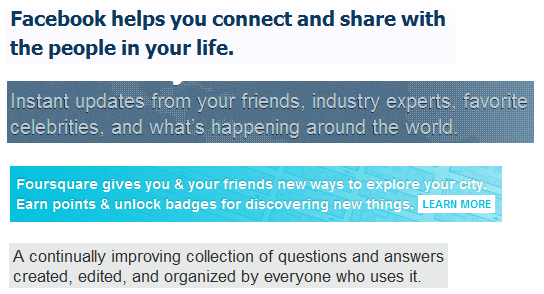
- Facebook – Facebook helps you connect and share with the people in your life.
- Twitter – Follow your interests. Instant updates from your friends, industry experts, favorite celebrities, and what’s happening around the world.
- Flickr – Share your life in photos.
- YouTube – Join the largest worldwide video-sharing community!
- Foursquare – Check in. Find your Friends. Unlock your City.
- Quora – A continually improving collection of questions and answers.
While for Google+ – No one cared to answer what product use-case it solves or what should users are expected to do on it.
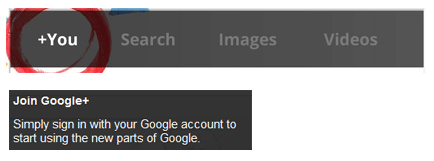
2. How does a user access Google+ ?
Users access Facebook on www.facebook.com; Twitter on www.twitter.com; and so on – is it www.google+.com?
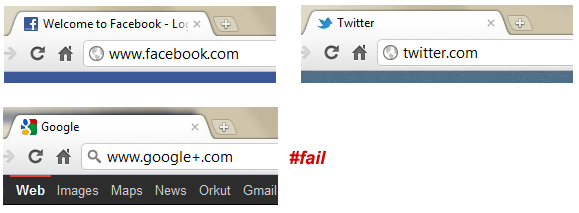
And to prove this point – look at Google+ suggestions on Search –
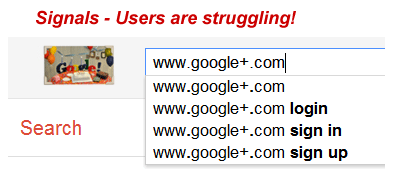
Accessibility is a big question mark for Google+. The correct way to access Google+ is plus.google.com – which a technology early adopter shall ‘probably’ remember – but even he or she will end up accessing (most of the time) Google+ from within GMail on the notification bar at the top.

This point is also related with next set of arguments – User Psychology & Naming & Identification Psychology. I feel these factors are extremely important to consider while building any consumer product.
3. User Psychology for Consumer Products
For any Internet or mobile product – consumers are quick to label it with its strongest product use-case – which is typically the recall product value of the user. Simply stated for a normal user –
- “I visit GMail to check my emails!”
- “I visit Google to search the web.”
- “I visit Facebook to view what my friends are up to.”
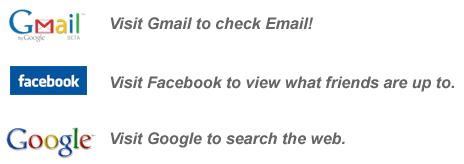
Now it is extremely difficult for any product to have a “and use-case” for a product –
- “I visit GMail to check my emails and Social Networking.” – No!
- “I visit Google to search the web and Social Networking.” – No!
- “I visit Facebook to view what my friends are up to and also searching the world wide web.” – No!
“And use-case” works for features that support any product’s core value. Features that would be to better manage emails (for Gmail), to better display search rankings (for Google Search), to show more types of friend’s activities (for Facebook) and so on.
Google is aiming to take on Facebook with a Social Networking product. But launched it like a feature on Google Homepage (Search) & Gmail (Notification Header). In current avatar, Google+ is a feature – and will gain traction as much as a feature can. It will not gain identity as a social-networking stand-alone product.
Also note the big failures of other “And use-cases” –
- “I visit Facebook to view what my friends are up to and also Buy Local Deals.” – Deals was abandoned by Facebook
- “I visit Facebook to view what my friends are up to and also to check-in in places” – Places as stand-alone attempt within Facebook failed, but as feature is gaining traction.
- “I visit Gmail to check mails and Buzz up articles.” – Google Buzz… remember?
“And use-cases” work for B2B products, but have never worked for any consumer web product.
.
4. Naming & Identification Psychology
Social Graphs & Social Networks are all about giving identity to users. Currently, Google+ itself needs an identity. Users think and will continue to think of Search when they think of Google, and it is virtually impossible for them to perceive Google as a Social Network.
How consumers relate with social activities – “Are you on FB?” “Can you tweet this?” “Let me share it on FB” and so on. The terminology “Google” or “Googled” is built over last 13 years – will be impossible to change from search to a social context.
For sake of Product identity or for its different product use-case, Google+ should have been outside of Google identity with its own identity (probably a www.plus.com if it was available). But the lure of exploring existing user-base is too difficult to give away – and if that logic was to succeed Yahoo! would have still been the largest internet company in this world. They tried to do everything under Yahoo! brand name (Yahoo! Search, Yahoo! Shopping, Yahoo! Finance, Yahoo! Hotjobs, Yahoo! This & Yahoo! That), but for consumers Yahoo! was and always remained a content play.
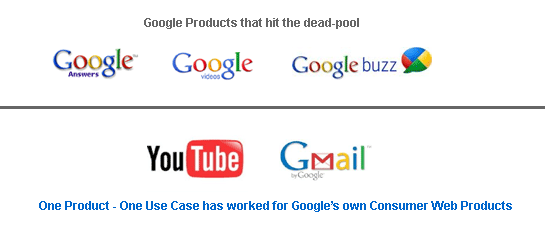
Even Google’s largely successful consumer products outside Search – Gmail & YouTube were successful because consumers saw it as an independent product identity outside the core of Google’s Search. While Google Video, Google Buzz, Google Answers – all failed. I am strong advocate of one-product = one-identity for consumer web businesses.
5. Social Graphs are occupied; No place for Google+ to fit in
I mentioned in my previous post Building Awesome Social Products – successful social products are reflection of people’s offline behavior in the real world. Similarly – successful social graphs are also reflection of people’s social relationships in real world. Social Products reflect activities, Social Graphs reflect relationships.
A typical user’s social relationships involve –
- Close Relationships – Friends, Family, Friendly Colleagues (present and past) – more importantly people you know personally.
- Professional Relationships – Colleagues, Business Relationships, Partners
- Loose Relationships – People you know, but they probably don’t know you. Celebrities, known professionals, domain experts
Facebook covers Close Relationships, LinkedIn covers Professional Relationships, Twitter covers Loose Relationships. So if Google+ is trying to create a new Social Graph, it will be a struggle (big struggle) – simply cause there is no use-case for a new social graph. Social graphs are distinct; by nature, by user behavior and are established over a period of time.
Features don’t make a product success by itself and expect it to later evolve in to a Social Graph; Instead having a use-case for social graph is essential and the features should evolve.
.
6. It is important to know whom to kill – Facebook, Blogs, Twitter, or what -?
Google+ though it presently looks like a Facebook killer – it is not. None of my friends are using it the way they use Facebook, instead I see more updates from technology adopters in Silicon Valley – and the posts look like extended tweets (beyond the 140 characters). I follow these technology adopters on Twitter, and hence my own assumption that probably it is a Twitter-killer.
Google+ still does not have a clear proposition – and is trying to overlap between all three Social Graphs (Close Relationships, Professional Relationships & Loose Relationships) without taking a clear positioning against one of them.
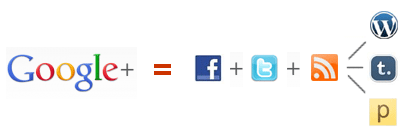
I am personally not happy with the killer-suffix (no products killers have ever killed anyone – they are still trying to kill iPhone & iPad). But its also important to know who your competition or what your benchmark really is. Or you might just try running behind all, but never able to catch up with any one of them.
.
7. Developer APIs will not enable Social Graphs; Instead Gmail invite contacts are more powerful.
There has been lot of noise about speculated Google+ APIs for developers to build applications and its release dates or so on. Developer APIs will provide access to features – posting an Google+ update, ability to do +1 through applications, and so on – but this sounds (unfortunately once again) like Twitter APIs or FB app APIs that allow you to post status updates and share pictures and so on. Most importantly, Google+ will not be able to build a Facebook Connect equivalent.
Today Social Graphs when referred are mostly Facebook explored through Facebook Connect (unless you write some algorithms on top of them to bring context to your product). F-Connect allows applications & developers to enable Social Graphs (of friends); which clearly explains why 1000s of applications prefer to have Sign-up with Facebook buttons.
Google+ has multiple circles (friends, acquaintances, doctors, techies – and you can delete and rename any other circle); relationships in these circle are mutually not dependent on each other – and hence cannot be explored even if Google+ comes out with a API to access them. Let me explain this below –
a. A user Larry might add another user Zuck in friends circle; Zuck may add Larry in My Gang circle. Hence social relationship between them is not mutual (as friends).
b. Further Larry might name his friends circle as Buddies; Zuck names his friends circles as Pals; Hence the social graph definition itself is flawed.

This is a huge flaw – Through APIs the developer’s applications cannot reach mutually accepted graph of both connections (mutual friends) or an validated status of their relationships (close friends, professional or loose). Hence at this stage it would be more preferred to use the Gmail Invite Contacts module – for simple reason that it is more powerful and treats all contacts at a same level (a social graph of email contacts / connections).
8. Not the best attempt at Social Networking
Google already knows so much about its users – whom do you chat (on GTalk), whom do you mail (on Gmail) or who are my most contacted people in real world (on Android). Google could have actually used a lot of this data, recommended people with circles (I still hate sorting people in circle all the time, but pre-cooked circles by associations would still have been so much better).
With Google holding so much data and wanting to go ahead with a strong social product; it is expecting users to do it again from scratch. Makes one feel that Google+ is a half-baked attempt.
Facebook users usually have about 150 to even 5000 friends. Usually added over years, and all added at a same level – ‘Friends’. However cool the task of adding people to circle is in execution – to add those many people again to circles is a pain. While most people that users see on Google+ are those who are discovered through the people you follow. Every time to add someone to a circle is little more effort than just adding as a friend (on Facebook) or just following the user (on Twitter).
Circle looks like Twitter lists – People get added on them once, later everyone forgets which user is put in what circle. And while the News feed (or stream) stays common for all – the Circles might as well be forgotten just like Twitter Lists.
The next point makes it more clear – why it is not the best attempt at Social Networking.
9. Real Capabilities of Social Graphs (or Networks) are absent –
Get this right – Friends (or Connections!) are the minimum one expects out of a Social Network. What stands out are the capabilities to engage those connections. Remember Orkut? – it had all connections; but Facebook just made the engagement so much better.
- Ability to discover Friends or Connections in context –
Google+ has done a simple job or fetching contact list from GMail and enabled it with the painful process (yes!) of adding to circles. But by enabling discovery of friends or connections who are active on Google+ – the suggestion engine for friends could have been so much better.
.
Example –
1. I end of following lot of product enthusiasts & early adopters. There are mutual connections that could be added to my circles – which currently not recommended.
2. My Gmail contacts list have endless email addresses of people I really don’t want to follow in circles or on any social network. So a smart recommendation based on whom I chat with, mutual friends, top contacts on Android and others need to be made discoverable.
.
- Stream or Newsfeed –
The most important discovery tool on any Social Platform is Newsfeed. In its current stage – the Stream on Google+ is very Twitterish – a timeline of all people you follow.
.
Facebook raised the standard with algorithms that help you discover feeds that is most relevant to every user, ranking every story contextually around a user. Newsfeed makes or breaks any Social Product and single most important activity & engagement enabler for any Social Product or Social Graph.
.
- Communication or Chat –
The most cut-copy-paste feature of Google+ is chat – where user can chat with contacts he otherwise can also on Gmail or Gtalk. Quite honestly, this is the most ridiculous feature, with no context to people any user has put in his circles.
.
In context of chat (or video chat) – expecting users to do Hangouts with webcam is a big No. Hangouts are not conversation starters, but should be featured alongside as planned video conversations.
.
- Ability to drive Traffic –
Remember Google Buzz? There was nothing wrong in the idea – attempting a Digg or Facebook Share or Tweet Share. Once a user Buzz’ed an article – it was critical to reach his Social Graph and drive viral traffic to that article. This story failed cause of poor dissemination of activity in user Social Graph. Google should learn lessons from Google Buzz chapter.
.
Social Networks like Facebook & Twitter are popular with publishers or businesses due to their ability to drive traffic to their own websites. While few publishers have added the +1 button to their webpages – still drives only an insignificant proportion of traffic to them; and lot of unclarity on how the dynamics of +1 button works for publishers and its benefits to them eventually.+1, Like, Share, Tweet this – are big distribution mechanisms for a Social Network. Should be given its required TLC.
.
As mentioned earlier – the product use-case should be driven by features; and not the other way round. Google can always come back and say – we are working on this. But hey, if a product is coming from a product & technology resource-heavy company like Google – even user expectations also very high.
Even these are early days for Google+, web is dynamic and consumer interests change quickly and Google can still do lots of changes quickly and innovate, possibly even work on the above arguments if they agree with it.
This post is written over last several days with some last minute additions on stats before hitting the publish button. Meanwhile Facebook has launched a series of new features, which looks like they are (over)reacting to Google+. Facebook, you are miles ahead, don’t make mistakes, please.









